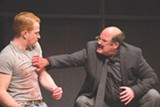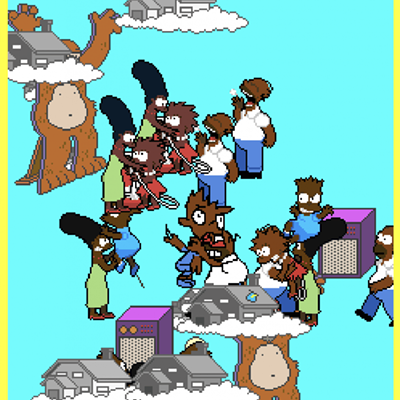[
{
"name": "500x250 Ad",
"insertPoint": "5",
"component": "15667920",
"parentWrapperClass": "",
"requiredCountToDisplay": "1"
}
]
Post-war artists became not painters of pictures, but painters of conditions, reflecting — in works that properly defied tangibility – the world's disillusionment. They expressed the mammoth weight of things that are universally experienced but not easily uttered. Viewing these works can therefore be something of a spiritual experience, where we reach out to touch but never grasp some greater, slippery form. Bearing this in mind, it is understandable that Mark Rothko felt conflicted about creating work for an upscale eatery, where it would be merely a pricey backdrop for fashion and social intrigue. Geva's current production is John Logan's "Red," a vignette of Rothko's struggle and self-sabotage through this period of time.
Set about a decade prior to his 1970 suicide, the one-act play takes place entirely in Rothko's studio, envisioning the conversations that might have taken place between a rather arrogant Rothko (played by Stephen Caffrey) and his eager young studio assistant, Ken (John Ford-Dunker).
After many shifts in style, Rothko rose to prominence for his ability to manipulate mood with pure hue floating in soft-focus color fields. In 1958, Rothko was commissioned by the Seagram and Sons beverage company to create a series of site-specific murals for The Four Seasons, a luxury restaurant in New York City.
Throughout the show, Rothko mostly avoids the gargantuan canvases, smoking and drinking his way through what might as well have been soliloquies, if not for the willful pushback of his assistant, who challenges his increasingly bitter statements. Ken may be "just an employee" to Rothko, but after two years, it's not entirely clear what Rothko is to Ken. Searching for meaning through his own tragic memories, Ken wants a mentor, and sticks by Rothko until he unwittingly relents.
Ford-Dunker plays Ken as young and hungry, opinionated and contentious, but as-yet unencumbered by the philosophical demons that ride Rothko. Ken flippantly challenges Rothko's artistic integrity and hypocrisies. As with all difficult humans, it becomes evident over time that Rothko's bluster and bullying comes from a place of deep dissatisfaction and despair. Having had a calloused hand in sweeping away the careers of his predecessors, Rothko dreads that karma will render him irrelevant before long.
Among other things, Ken represents a cock-sure new wave of artists. Instead of the cross-generation contact having a quickening effect on Rothko, there is mostly a battle of stubborn wills.
But it's evident that Rothko still trusts in the power of his work's resonance; he only desires control over how it will be presented. The Four Seasons commission was a golden egg, but a blemished one – in one particularly sneering speech, Rothko balks at the idea of his work becoming one more decorative trophy at this decadent feasting trough of the elite.
Rothko felt his art required a place for quiet reflection in order for it to work its mysteries on the viewer. He knew the proximity required for immersion, urging Ken to step closer than we usually do to large paintings, and let the peripheral world dissolve. Through Rothko's rants, the play itself makes reference to the chapel that would become the setting for his final commission of paintings before his death.
Art critic Jerry Saltz aptly described Rothko's work as "Buddhist TV's," or what Keats called "good oblivion." Fine, that's a good starting place. But the seed of something greater is meant to be awakened from meditation, and this seems to be what Rothko was after.
It's a given that the artist has little control over how his art is interpreted, received, or appreciated. But the artist's intention is arguably part of the art's legacy and spirit. Ken serves as sort of a foil for Rothko's greater audience, in that he helplessly brings his own associations to the table when viewing Rothko's nearly blank-slate paintings.
One of my favorite meditations about the act of creating came from another tragic visionary, David Foster Wallace. He said that the difference between "good" art and "so-so" art "lies somewhere in the art's heart's purpose, the agenda of the consciousness behind the text. It's got something to do with love. With having the discipline to talk out of the part of yourself that can love instead of the part that just wants to be loved."
Rothko's work arguably was coming from a place of love, but also all of the messiness that love entails: fear, vulnerability, hope, and in the case of this commission, spite. But the paintings don't retain that precise emotion. The play's most pivotal moment sees Rothko's obstinate mood shift to a concession of defeat. In the "Red" paintings, Rothko's act of passing the torch is distilled, happening forever, eternally fading to black.
The Memorial Art Gallery has partnered with Geva for this production, by borrowing Rothko's "Untitled" (1961) painting from the Buffalo's Albright-Knox Art Gallery. The painting will be on view at the MAG through the run of the show.
Latest in Art
More by Rebecca Rafferty
-

Beyond folklore
Apr 4, 2024 -

Partnership perks: Public Provisions @ Flour City Bread
Feb 24, 2024 -

Raison d’Art
Feb 19, 2024 - More »






